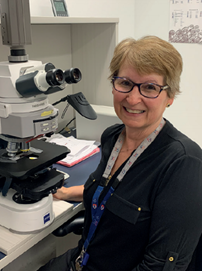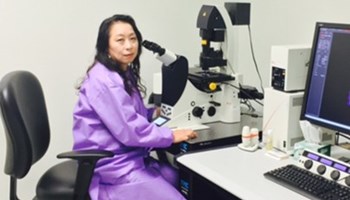 Any lab working with FFPE (formalin-fixed, paraffin-embedded) tissue samples for FISH (fluorescence in situ hybridisation) will know that this type of sample can be problematic and deliver highly variable results. Differences in the fixation process, type and density of the tissue or age of the sample can all cause issues with the vital pretreatment process that reverses the formalin fixation cross links and digests tissue components to allow probe access to target DNA. Failure to optimally digest these tissues results in poor or even no results, and ‘homebrew’ pretreatment solutions can often become overly complicated, plus time and labour intensive.
Any lab working with FFPE (formalin-fixed, paraffin-embedded) tissue samples for FISH (fluorescence in situ hybridisation) will know that this type of sample can be problematic and deliver highly variable results. Differences in the fixation process, type and density of the tissue or age of the sample can all cause issues with the vital pretreatment process that reverses the formalin fixation cross links and digests tissue components to allow probe access to target DNA. Failure to optimally digest these tissues results in poor or even no results, and ‘homebrew’ pretreatment solutions can often become overly complicated, plus time and labour intensive.
OGT’s Cytocell Tissue Pretreatment Kit uses optimised, ready-to-use reagents in a simple two-stage FFPE slide preparation protocol to increase the permeability of cell membranes and facilitate penetration of FISH or CISH DNA probes. We spoke to Carmen Vokaty, Assistant-Chief Medical Technologist in Cytogenetics at the McGill University Health Centre, about how her lab incorporated the kit into its workflow after struggling with a homebrew solution. She explains how the kit revolutionised her lab’s pretreatment process and the quality of FISH results, enabling the lab to save time, increase capacity and dramatically reduce the need to repeat samples, if any non-retrievable tissue were still available.
I have a Bachelor’s degree in Science with a specialisation in Biology and a Registered Medical Technologist Certificate in Cytogenetics. My career began in a genetics research lab, then after five years I moved to a clinical cytogenetics lab where I have been working for the past 32 years.
I am currently the assistant chief medical technologist in the Cytogenetics lab at the McGill University Health Centre. My responsibilities include the daily lab operations, overseeing staff training and developing and implementing new techniques in the lab.
We are a full service lab with 15 full time technologists processing approximately 4000 samples a year. We provide diagnostic services to several departments including genetics, pathology and haematology.
Our lab performs standard cytogenetic testing on bone marrow, blood and some prenatal samples. We also do a significant amount of FISH testing, mostly on paraffin and bone marrow samples.
When we began doing FFPE FISH using a homebrew pretreatment protocol, it was long and tedious. As we expanded our FISH testing we found that different tissue types didn’t work well using a standard protocol. We needed to alter a number of parameters to be able to successfully process each sample type. This consisted in using different concentrations of pepsin, depending on the tissue we were processing as well as pepsin from different vendors. It was a very cumbersome procedure for our technologists. The pepsin was difficult to weigh out accurately and the sodium thiocynate, required for pretreating the slides before digestion, was toxic.
On top of all that we had to perform checks with DAPI after digestion, before adding the probe, to confirm the tissue was sufficiently digested. If it wasn’t digested enough we had to wash off the DAPI and digest again in pepsin. This pretreatment process could take an entire day to complete!
Our homebrew pretreatment method was not working well for us. It was very inconsistent and time consuming and we were repeating samples time and time again. We had to find a solution. I mentioned this to my OGT representative and they informed me they had a tissue pretreatment kit available. After reading over the procedure, I was impressed by the ease of the technique and how rapid the protocol was, so we were happy to try it.
It is a godsend, it’s wonderful! It just works – there is something in the tissue pretreatment kit that digests the tissue so well. It works for all the probes we use, whether from Cytocell or other vendors. There is less manipulation needed and it’s easy to use – no more weighing out of reagents, and very reproducible results.
It has saved us an incredible amount of time; now the entire pretreatment process, including probing, takes just three hours rather than a full day, which has increased our capacity. We no longer have to repeat 50% of our samples, more like 5%.
Better digestion of the tissue using the Cytocell pretreatment kit has also resulted in brighter signals and easier and faster scoring of the samples.
I’ve always clicked with OGT representatives; they are very personable, always easy to contact and quick to respond to my questions – which is great. Cytocell probes are great, we use many of them in our lab, the signals are bright and we find there is much less background compared to similar probes from other companies.
With regard to the pretreatment kit, I would say to anyone having problems or difficulty with tissue digestion, try OGT’s Cytocell Tissue Pretreatment Kit because it has changed our lives!
CytoCell®: product availability may vary from country to country and is subject to varying regulatory requirements. Please contact your local representative for availability.

Dr Jennie Thurston, Director of Cytogenetics, Carolinas Pathology Group, Atrium Health, explains how OGT's CytoCell® FISH probes were seamlessly incorporated into the automated workflow for fast, high quality results.
Read
Dr. Theresa C. Brown, Tulane University School of Medicine, answer questions around her AGT 2017 presentation 'FISHing with the real-life laboratory experts.'
Read
Megumi Hada, PhD, Senior Research Scientist, RaISE, Prairie View, Texas A&M. answers our questions on space radiation, how it affects astronaut health, and what her research can teach us about the biological effects of radiation here on Earth.
Read